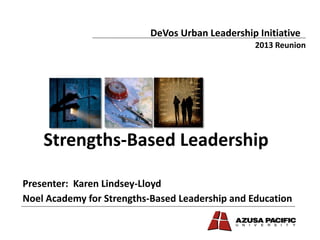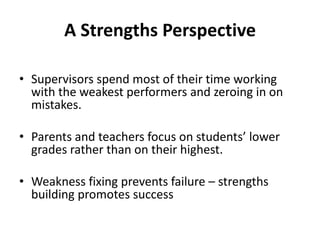013 devos four domains of leadership
- 1. Strengths-Based Leadership DeVos Urban Leadership Initiative Noel Academy for Strengths-Based Leadership and Education 2013 Reunion Presenter: Karen Lindsey-Lloyd
- 3. TodayŌĆÖs Agenda ŌĆó Defining Strength ŌĆó History of Strengths ŌĆó Understanding Strengths ŌĆó Leading with Strengths
- 4. What is a Strength? A strength is "a pre-existing capacity for a particular way of behaving, thinking, or feeling that is authentic and energizing to the user, and enables optimal functioning, development, and performanceŌĆØ (Linley, 2008, p.9) Talent: naturally recurring patterns of thought, feeling, or behavior that can be productively applied.
- 5. History of Strengths ŌĆó Developed using theoretical foundation of positive psychology based on the research of Seigelman & Csikszentmihalyi, 2000. ŌĆó Leadership is relational so you must understand yourself before you can lead others. 5
- 6. History of Strengths Research on High Achievers ŌĆó Dr. Don Clifton, Gallup Organization ŌĆó 250,000 interviews of high achieving individuals ŌĆó Spend most of their time in areas of strength
- 7. History of Strengths Research on High Achievers ŌĆó Have learned to delegate or partner ŌĆó Apply their strengths to overcome obstacles ŌĆó Invent ways of capitalizing on their strengths in new situations
- 8. ŌĆó (Talent + Energy) x (Knowledge + Skill) = The Strengths Equation Strength
- 9. ŌĆó Process information ŌĆó Experience others ŌĆó View time and structure ŌĆó Accommodate change ŌĆó Communicate Our strengths affect the way weŌĆ”
- 10. A Strengths Perspective ŌĆó Not about the tool ŌĆó Not about the labels ŌĆó Not about the deficits Definitely about knowing your God-given talents and using them to the fullest covered in prayer
- 11. ŌĆó Individuals already have within themselves what they need to succeed. ŌĆó ŌĆ£Individuals gain more when they build on their talents, than when they make comparable efforts to improve their areas of weakness.ŌĆØ Clifton & Harter, 2003, p. 112 What is a Strengths Perspective?
- 12. A Strengths Perspective ŌĆó Supervisors spend most of their time working with the weakest performers and zeroing in on mistakes. ŌĆó Parents and teachers focus on studentsŌĆÖ lower grades rather than on their highest. ŌĆó Weakness fixing prevents failure ŌĆō strengths building promotes success
- 13. S t ra t e g i c T h i n k i n g Focus on what could be. Analyze information and help the team consider future possibilities and making prudent decisions. Analytical, Context, Futuristic, Ideation, Input, Intellection, Learner, and Strategic E xe c u t i n g Know how to make things happen. Implement plans and get things done. Take plans from ideas to reality. Focus on task completion and goal achievement. Work diligently to Achiever, Arranger, Belief, Consistency, Deliberative, Discipline, Focus, Responsibility, and Restorative Re l a t i o n s h i p B u i l d i n g Skilled at creating synergy within the team and/or organization. Keep morale of team members high. Consider needs of team members. Minimize distractions. Adaptability, Developer, Connectedness, Empathy, Harmony, Includer, Individualization, Positivity, and Relator I n f l u e n c i n g Help the team reach a broader audience. Give voice to teamŌĆÖs ideas, plans, and vision. Skilled at taking charge, speaking up, and getting others inside and outside the organization to buy-in. Activator, Command, Communication, Competition, Maximizer, Self-Assurance, Significance, and Woo Rath and Conchie, 2008 Four Domains of Leadership Strength
- 14. ŌĆó Competition, Command ŌĆō Harmony ŌĆó Individualization ŌĆō Consistency ŌĆó Context ŌĆō Futuristic ŌĆó Strategic ŌĆō Strategic Strengths That Naturally Conflict
- 15. Strengths That Naturally Conflict ŌĆó Activator ŌĆō Deliberative, Analytical ŌĆó Responsibility, Belief ŌĆō Adaptability ŌĆó Discipline ŌĆō Input ŌĆó Communication ŌĆō Intellection
- 16. ŌĆó ŌĆ£There are almost as many definitions of leadership as there are people who have tried to define it.ŌĆØ (Stogdill, 1974, p. 7) What about leadership?
- 17. Personal Action Plan My Top Five How I use it (currently) Place an ŌĆ£XŌĆØ here for the strength you use most 1. 2. 3. 4. 5. What three things can I do when I return that will better leverage my strengths? (Make them SMART) 1. 2. 3. Who will hold me accountable?
- 18. Questions? ŌĆó Thank you! ŌĆó Twitter: @klinlloyd ŌĆó LinkedIn: www.linkedin.com/in/klinlloyd


















